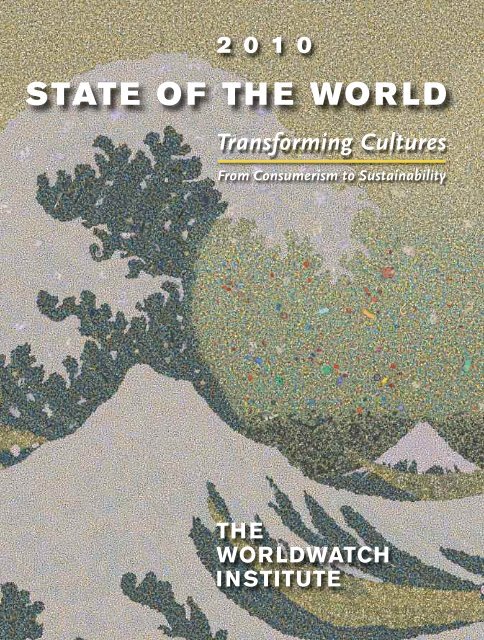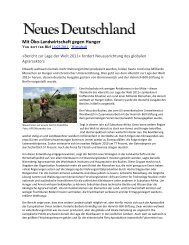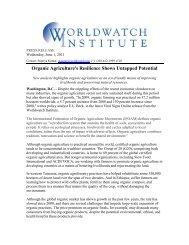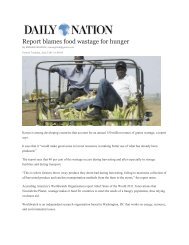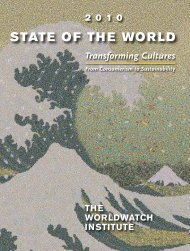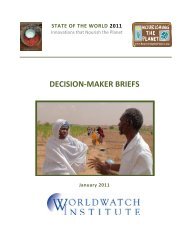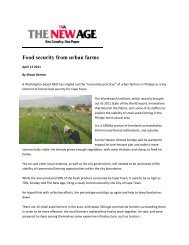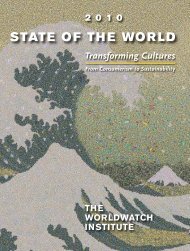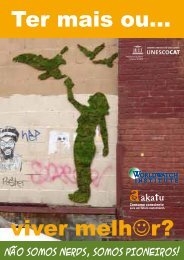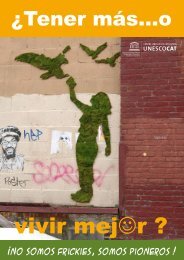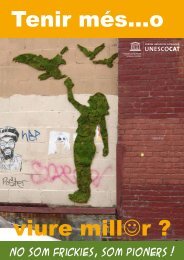Early Childhood Education to Transform Cultures for Sustainability
Early Childhood Education to Transform Cultures for Sustainability
Early Childhood Education to Transform Cultures for Sustainability
You also want an ePaper? Increase the reach of your titles
YUMPU automatically turns print PDFs into web optimized ePapers that Google loves.
2 0 1 0<br />
STATE O F TH E WO R LD<br />
<strong>Trans<strong>for</strong>m</strong>ing <strong>Cultures</strong><br />
From Consumerism <strong>to</strong> <strong>Sustainability</strong><br />
THE<br />
WORLDWATCH<br />
INSTITUTE
SCIENCE/ENVIRONMENT<br />
B<br />
STATE OF TH E WOR LD<br />
Advance Praise <strong>for</strong> State of the World 2010:<br />
“If we continue <strong>to</strong> think of ourselves mostly as<br />
consumers, it’s going <strong>to</strong> be very hard <strong>to</strong> bring our<br />
environmental troubles under control. But it’s also<br />
going <strong>to</strong> be very hard <strong>to</strong> live the rounded and joyful<br />
lives that could be ours. This is a subversive volume<br />
in all the best ways!”<br />
—Bill McKibben, author of Deep Economy and<br />
The End of Nature<br />
“Worldwatch has taken on an ambitious agenda in<br />
this volume. No generation in his<strong>to</strong>ry has achieved a<br />
cultural trans<strong>for</strong>mation as sweeping as the one called<br />
<strong>for</strong> here…it is hard not <strong>to</strong> be impressed with the<br />
book’s boldness.”<br />
—Muhammad Yunus, founder of the Grameen Bank<br />
“This year’s State of the World report is a cultural<br />
mindbomb exploding with devastating <strong>for</strong>ce. I hope<br />
it wakes a few people up.”<br />
—Kalle Lasn, Edi<strong>to</strong>r of Adbusters magazine<br />
Like a tsunami, consumerism has engulfed human<br />
cultures and Earth’s ecosystems. Left unaddressed, we<br />
risk global disaster. But if we channel this wave, intentionally<br />
trans<strong>for</strong>ming our cultures <strong>to</strong> center on sustainability,<br />
we will not only prevent catastrophe but may usher in an<br />
era of sustainability—one that allows all people <strong>to</strong> thrive<br />
while protecting, even res<strong>to</strong>ring, Earth.<br />
In this year’s State of the World report, 50+ renowned<br />
researchers and practitioners describe how we can<br />
harness the world’s leading institutions—education, the<br />
media, business, governments, traditions, and social<br />
movements—<strong>to</strong> reorient cultures <strong>to</strong>ward sustainability.<br />
W. W. N O R T O N<br />
N E W Y O R K • L O N D O N<br />
2 0 1 0<br />
<strong>Trans<strong>for</strong>m</strong>ing <strong>Cultures</strong><br />
From Consumerism <strong>to</strong> <strong>Sustainability</strong><br />
www.worldwatch.org<br />
full image<br />
extreme close-up<br />
Several million pounds of plastic<br />
enter the world’s oceans every hour,<br />
portrayed on the cover by the 2.4<br />
million bits of plastic that make up<br />
Gyre, Chris Jordan’s 8- by 11-foot<br />
reincarnation of the famous 1820s<br />
woodblock print, The Great Wave<br />
Off Kanagawa, by the Japanese artist<br />
Katsushika Hokusai.<br />
For discussion questions,<br />
additional essays,<br />
video presentations,<br />
and event calendar, visit<br />
blogs.worldwatch.org/<br />
trans<strong>for</strong>mingcultures.<br />
Cover image: Gyre by Chris Jordan<br />
Cover design: Lyle Rosbotham
<strong>Early</strong> <strong>Childhood</strong> <strong>Education</strong> <strong>to</strong> <strong>Trans<strong>for</strong>m</strong><br />
<strong>Cultures</strong> <strong>for</strong> <strong>Sustainability</strong><br />
Ingrid Pramling Samuelsson and Yoshie Kaga<br />
In view of the unprecedented challenges presented<br />
by continuing population growth, environmental<br />
destruction, and ever-shrinking<br />
resource availability, education at all levels<br />
should be reviewed <strong>to</strong> give a stronger focus on<br />
its role of promoting values, attitudes, practices,<br />
habits, and lifestyles that promote sustainability.<br />
As part of this ef<strong>for</strong>t, the education of<br />
children in their youngest years deserves special<br />
attention.<br />
Research shows that the human brain and<br />
biological pathways develop rapidly and that<br />
children’s experiences be<strong>for</strong>e they start primary<br />
school shape their attitudes, values, behaviors,<br />
habits, skills, and identity throughout life. Thus<br />
the first years of life provide a window of opportunity<br />
<strong>for</strong> nurturing children’s love of nature and<br />
the habits, practices, and lifestyles that favor<br />
sustainability. (See Box 6.) Basic life skills such<br />
as communication, cooperation, au<strong>to</strong>nomy, creativity,<br />
problem-solving, and persistence are<br />
acquired in these early years, and the motivation<br />
<strong>to</strong> learn is put in place. 1<br />
This is an ideal time <strong>to</strong> look at how <strong>to</strong> connect<br />
early childhood education programs <strong>to</strong> a<br />
sustainability agenda because these programs<br />
have increased dramatically in recent years, in<br />
part due <strong>to</strong> changing family structures and<br />
the increased number of women in the work<strong>for</strong>ce.<br />
About a third of young children in western<br />
industrial countries are now being looked<br />
after outside the home from the age of one or<br />
younger, and most children are in early childhood<br />
programs <strong>for</strong> at least two years be<strong>for</strong>e<br />
they start primary schooling. Between 1999<br />
and 2006, the global pre-primary percentage<br />
of children aged one <strong>to</strong> five who were enrolled<br />
in a kindergarten or the equivalent grew from<br />
33 <strong>to</strong> 40 percent. The share of children in<br />
such educational settings varies widely around<br />
the world, however. By 2006 the figures were<br />
14 percent in sub-Saharan Africa, 18 percent<br />
in the Arab states, 45 percent in East Asia and<br />
the Pacific, 65 percent in Latin America and the<br />
Caribbean, and 81 percent in North America<br />
and Western Europe. 2<br />
<strong>Early</strong> <strong>Childhood</strong> <strong>Education</strong><br />
Can Help Make the Shift<br />
<strong>Early</strong> childhood education can help build a<br />
culture of sustainability if it is framed in terms<br />
of sustainable development, if curriculum and<br />
pedagogical guidelines are oriented <strong>to</strong>ward<br />
Ingrid Pramling Samuelsson is a professor in early childhood education at Gothenburg University in<br />
Sweden. Yoshie Kaga is a program specialist in early childhood care and education at UNESCO.<br />
BLOGS.WORLDWATCH.ORG/TRANSFORMINGCULTURES 57
<strong>Early</strong> <strong>Childhood</strong> <strong>Education</strong> <strong>to</strong> <strong>Trans<strong>for</strong>m</strong> <strong>Cultures</strong> <strong>for</strong> <strong>Sustainability</strong> STATE OF THE WORLD 2010<br />
Box 6. <strong>Sustainability</strong> and the Human-Nature Relationship<br />
Humans depend on the natural world <strong>to</strong> meet<br />
all their basic needs, including air, water, food,<br />
energy, and shelter. Studies suggest that<br />
contact with natural environments, living creatures,<br />
and ecological systems is also critical<br />
<strong>for</strong> healthy human development, particularly<br />
the development of a healthy self-concept.<br />
Psychologists have observed that children<br />
as well as adults benefit from “ecological<br />
development” in which they create or move<br />
<strong>to</strong>ward an understanding of themselves in<br />
relation <strong>to</strong> the non-human world.<br />
Yet many people are increasingly isolated<br />
from nature. According <strong>to</strong> the 2008 Outdoor<br />
Recreation Participation Report, participation<br />
in outdoor activities among U.S. youngsters<br />
aged 6 <strong>to</strong> 17 declined 11.6 percent between<br />
2006 and 2007, with the sharpest drops<br />
among 6- <strong>to</strong> 12-year-olds. The time that young<br />
people spend indoors is associated with<br />
increasing levels of computer, video, and<br />
technology use and decreasing levels of<br />
physical activity. The negative health effects<br />
of this trend, from depression <strong>to</strong> obesity and<br />
diabetes, are well documented.<br />
Research indicates that repeated, regular,<br />
and sustained positive experiences in natural<br />
environments are influential <strong>for</strong> attaining sustainable<br />
behaviors and lifestyles. Journalist<br />
Richard Louv, in his 2005 book Last Child in the<br />
Woods, points <strong>to</strong> the psychological and physical<br />
benefits of greater interaction with nature.<br />
Children in particular can benefit from opportunities<br />
<strong>for</strong> unstructured play in semi-natural<br />
environments close <strong>to</strong> home. Such in<strong>for</strong>mal<br />
outdoor experiences may be more powerful<br />
than the <strong>for</strong>mal, classroom-based environmental<br />
education that has gained ground in many<br />
countries in the last 30 or so years.<br />
In the United States, Louv’s book inspired<br />
the drafting in 2007 of the No Child Left<br />
Inside Act, designed <strong>to</strong> guarantee every<br />
American child (in particular, impoverished<br />
inner-city youth) effective and educationally<br />
significant access <strong>to</strong> outdoor nature. Although<br />
this legislation has not yet been adopted, it<br />
signals rising concern in the world’s largest<br />
consumer culture about the next generation’s<br />
experience in and with natural environments—<br />
the outdoors.<br />
Outdoor and environmental education<br />
have a long-standing tradition in countries<br />
such as Germany, Norway, the United<br />
Kingdom, Australia, and New Zealand.<br />
Their <strong>for</strong>mal educational ef<strong>for</strong>ts are often<br />
complemented by a strong outdoor recreation<br />
and wilderness tradition. Examples include<br />
the Wandervogel and youth hostelling<br />
movement in Germany, friluftsliv in Norway<br />
(open air life/life in nature), and the scouting<br />
and outdoor education tradition in the United<br />
Kingdom, Australia, and New Zealand. Summer<br />
camps in the United States and Canada,<br />
along with Canada’s cottage culture, promote<br />
active interaction with natural environments.<br />
What unites all these activities is the intent <strong>to</strong><br />
develop a relationship in which the effects of<br />
human behavior on nature and “self” become<br />
felt, experienced, and valued.<br />
For many people, especially those in the<br />
westernized world, the most direct relationship<br />
they have with nature (apart from the air<br />
they breathe) is through the food and water<br />
they consume. Ef<strong>for</strong>ts <strong>to</strong> live more sustainably<br />
though food choices are thus a critical and<br />
integral element in the systemic shift <strong>to</strong> a culture<br />
of sustainability. Trends such as the bioregional<br />
movement, the rise in community and<br />
market gardens, increasing interest in local<br />
and organic food, and the embrace of vegetarianism<br />
all suggest an attempt <strong>to</strong> res<strong>to</strong>re a<br />
more direct, immediate, and enriching<br />
human-nature relationship.<br />
—Almut Beringer<br />
Direc<strong>to</strong>r of <strong>Sustainability</strong>,<br />
University of Wisconsin<br />
58 WWW.WORLDWATCH.ORG
STATE OF THE WORLD 2010 <strong>Early</strong> <strong>Childhood</strong> <strong>Education</strong> <strong>to</strong> <strong>Trans<strong>for</strong>m</strong> <strong>Cultures</strong> <strong>for</strong> <strong>Sustainability</strong><br />
education <strong>for</strong> sustainability, if staff training in<br />
this field is rein<strong>for</strong>ced, and if parents and communities<br />
are involved in the process.<br />
In May 2007 an international workshop on<br />
the role of early childhood education in a sustainable<br />
society brought early childhood professionals<br />
and experts from 16 countries <strong>to</strong><br />
Gothenburg, Sweden. Participants recognized<br />
that there was a great deal in the traditions of<br />
early childhood pedagogies that aligns with<br />
education <strong>for</strong> sustainability, such as the interdisciplinary<br />
approach, the use of the outdoors<br />
<strong>for</strong> learning, learning through concrete experiences<br />
and real-life projects, and the involvement<br />
of parents and communities. A subsequent<br />
conference in Gothenburg in November 2008<br />
recommended that early childhood education<br />
should be conceived as a first step in learning<br />
<strong>to</strong> live sustainably, should be given more priority<br />
in policy development, should receive more<br />
resources, and should involve cross-sec<strong>to</strong>ral<br />
support and collaboration. 3<br />
It is important that the goals and content of<br />
early childhood curriculum be aligned with<br />
education <strong>for</strong> sustainability. In this exercise,<br />
environmental education is not the only component.<br />
In addition <strong>to</strong> fostering love <strong>for</strong> and<br />
respect <strong>to</strong>ward nature and promoting an awareness<br />
of problems due <strong>to</strong> unsustainable lifestyles,<br />
early childhood education must encourage the<br />
outlook and basic skills that enable children <strong>to</strong><br />
take in<strong>for</strong>med actions responsibly. Instead of<br />
the 3Rs of reading, writing, and arithmetic,<br />
early childhood education can follow the 7Rs—<br />
reduce, reuse, recycle, respect, reflect, repair,<br />
and responsibility:<br />
• Reduce is about reducing the consumption<br />
of food, materials, and resources, which may<br />
involve working with parents on the problem<br />
of children’s exposure <strong>to</strong> advertisements promoting<br />
endless consumption.<br />
• Reuse is about showing children that materials<br />
can be used many times <strong>for</strong> different purposes<br />
in preschool and at home.<br />
• Recycle can be encouraged by asking children<br />
<strong>to</strong> bring recyclable materials <strong>to</strong> school and<br />
integrating them in<strong>to</strong> a range of activities.<br />
• Respect is about nurturing understanding of<br />
and respect <strong>for</strong> nature and natural processes<br />
and reducing the extent <strong>to</strong> which they are<br />
violated.<br />
• Reflect is a habit and skill everybody will<br />
benefit from in working <strong>for</strong> sustainability.<br />
• Repair involves taking care of broken <strong>to</strong>ys<br />
and other objects and repairing them.<br />
• Responsibility is about trusting children <strong>to</strong><br />
take care of something or do something they<br />
can feel proud about. 4<br />
There is much in the world that is unknown<br />
<strong>to</strong> children. Working <strong>to</strong>ward making the<br />
unknown visible <strong>to</strong> them means creating<br />
opportunities <strong>to</strong> discover the unknown in what<br />
they do and work with. This puts demands on<br />
early childhood teachers <strong>to</strong> be aware of what<br />
a child’s learning should be directed <strong>to</strong>ward. 5<br />
At the same time, there are also unknown<br />
phenomena <strong>for</strong> the teachers, particularly concerning<br />
the future. From a pedagogical perspective,<br />
this is a difficult challenge. One way<br />
<strong>to</strong> deal with this might be <strong>to</strong> try <strong>to</strong> identify<br />
what all children may benefit from having in<br />
the future. Eva Johansson suggests that<br />
courage, integrity, critical thinking, and responsibility<br />
are necessary personal attributes in<br />
order <strong>to</strong> be prepared <strong>for</strong> an unknown future.<br />
Also, it is important <strong>to</strong> nurture the ability <strong>to</strong><br />
recognize injustice, as well as <strong>to</strong> be skilled and<br />
creative in solving complex questions. If children<br />
are given ample opportunities <strong>to</strong> be challenged,<br />
<strong>to</strong> make mistakes, and <strong>to</strong> enjoy seeking<br />
possible answers, they will be better equipped<br />
<strong>to</strong> confront the complex questions raised by<br />
sustainable development. 6<br />
At the heart of teaching and working with<br />
young children should be the notion of the<br />
rich and competent child and active citizen,<br />
being in an equal position as his or her teacher,<br />
constructing understanding and meanings<br />
with others. The “project approach” is a teaching<br />
strategy that addresses children’s intellec-<br />
BLOGS.WORLDWATCH.ORG/TRANSFORMINGCULTURES 59
Courtesy Earth Sangha<br />
<strong>Early</strong> <strong>Childhood</strong> <strong>Education</strong> <strong>to</strong> <strong>Trans<strong>for</strong>m</strong> <strong>Cultures</strong> <strong>for</strong> <strong>Sustainability</strong> STATE OF THE WORLD 2010<br />
tual dispositions, allowing children <strong>to</strong> examine<br />
the basis of their own opinions, ideas, and<br />
assumptions. This strategy will help them<br />
examine the behaviors of their own cultures<br />
and others in terms of implications <strong>for</strong> sustainable<br />
development. 7<br />
Young students plant a vegetable garden at their elementary<br />
school in Washing<strong>to</strong>n, D.C.<br />
It is not necessary <strong>to</strong> invent entirely new<br />
pedagogies in order <strong>to</strong> “do” education <strong>for</strong><br />
sustainability in the early years; it is possible <strong>to</strong><br />
build on pedagogical traditions instead. Arjen<br />
Wals points <strong>to</strong> the qualities in the pedagogical<br />
tradition of early childhood education that<br />
are particularly useful <strong>for</strong> education <strong>for</strong> sustainability—qualities<br />
that other levels of education<br />
may lack: “So let us return <strong>to</strong><br />
kindergarten and explore why kindergartens<br />
offer more <strong>for</strong> moving <strong>to</strong>wards a more sustainable<br />
world than many of our universities.<br />
Kindergarten ideally is or can be places where<br />
young children live and learn, explore boundaries,<br />
in a safe and transparent world without<br />
hidden agendas….There are no dumb questions<br />
in kindergarten and there’s always time<br />
<strong>for</strong> questions and questioning.” 8<br />
Research shows that the traditional subjectbased<br />
teaching of knowledge that is common<br />
in schools does not give the best results in<br />
learning about issues related <strong>to</strong> sustainable<br />
development, which are interdisciplinary in<br />
nature. Furthermore, modeling behavior is<br />
found <strong>to</strong> be more effective than direct teaching<br />
or preaching in helping young children internalize<br />
values and develop desirable attitudes<br />
and leanings. Children should<br />
have role models who can make these<br />
values and characteristics visible and<br />
“lived” in daily settings, including early<br />
childhood centers, schools, and families,<br />
as well as through various public<br />
media. 9<br />
Families, indeed, are the child’s first<br />
educa<strong>to</strong>rs. They have the greatest influence<br />
in shaping young children’s attitudes,<br />
values, behaviors, habits, and<br />
skills. So they have a central role <strong>to</strong> play<br />
in educating their children <strong>for</strong> sustainable<br />
development. And grandparents<br />
often have age-old wisdom about ways<br />
of life that favor living <strong>to</strong>gether, the<br />
preservation of nature throughout generations,<br />
and cohabitation with different<br />
species—wisdom that should be tapped.<br />
Thus where <strong>for</strong>mal early education programs<br />
are not available, non-<strong>for</strong>mal education can be<br />
set up—as an integral component of community<br />
programs or otherwise—<strong>to</strong> provide parents<br />
and grandparents with opportunities <strong>to</strong> discuss<br />
what could be done differently in daily life in<br />
order <strong>to</strong> encourage or enable sustainable development.<br />
Where an early childhood education<br />
program does exist, the participation of parents<br />
can strengthen the link between what takes<br />
place in the education setting and at home. 10<br />
Case Studies on Young Children<br />
and <strong>Sustainability</strong><br />
The May 2007 workshop in Sweden highlighted<br />
numerous examples of how <strong>to</strong> get<br />
young children involved with questions about<br />
sustainable development. In one case in Aus-<br />
60 WWW.WORLDWATCH.ORG
STATE OF THE WORLD 2010 <strong>Early</strong> <strong>Childhood</strong> <strong>Education</strong> <strong>to</strong> <strong>Trans<strong>for</strong>m</strong> <strong>Cultures</strong> <strong>for</strong> <strong>Sustainability</strong><br />
tralia, <strong>for</strong> example, children have numerous<br />
opportunities <strong>to</strong> act as agents of change <strong>for</strong> sustainability.<br />
They work on such mini-projects as<br />
litter-less lunches, responsible cleaning, reusing<br />
and recycling things, a vegetable garden, a<br />
register of native plants, environmental aesthetics,<br />
efficient use of natural resources, and<br />
construction of a frog pond. They also worked<br />
on lifestyle questions such as waste management<br />
as well as the “eco-friendliness” of their<br />
outdoor environment. The teacher skillfully<br />
designs the activities based on the children’s<br />
interests. They work collaboratively and ensure<br />
that in<strong>for</strong>med, reflective practice infuses interactions<br />
and deliberations. 11<br />
Another example is a case study from Japan,<br />
where the project approach was practiced in<br />
a preschool in relation <strong>to</strong> the cycle of the silkworm,<br />
a fascinating insect. Silk and silkworms<br />
have a long use and cultural meaning in traditional<br />
clothes in Japan, yet the mulberry<br />
trees—which provide the natural food of silkworms—are<br />
disappearing in the school’s<br />
neighborhood. Children learned the whole<br />
ecological cycle surrounding silkworms by<br />
experiencing, hands on, the growth of<br />
cocoons in<strong>to</strong> caterpillars in less than 25 days,<br />
observing how caterpillars eat and when silk<br />
fibers are produced. While the project was<br />
mainly focusing on nature, culture and economy<br />
were included as well when the teachers<br />
discussed silk clothing and the silk industry in<br />
Japanese society. 12<br />
The last example is from Sweden. The<br />
Swedish national curriculum <strong>for</strong> early childhood<br />
education and care clearly spells out that<br />
teachers are responsible <strong>for</strong> promoting respect<br />
<strong>for</strong> the intrinsic values of each person as well<br />
as <strong>for</strong> the shared environment. It also very<br />
specifically focuses on children acquiring a car-<br />
ing attitude <strong>to</strong> nature and the environment as<br />
well as an understanding that they are part of<br />
nature’s regeneration process. The curriculum<br />
asks teachers <strong>to</strong> address ethical dilemmas,<br />
and it regards gender equality as a precondition<br />
<strong>for</strong> a sustainable society. 13<br />
Current Challenges in <strong>Early</strong><br />
<strong>Childhood</strong> <strong>Education</strong><br />
Although an individual’s capacity <strong>to</strong> learn is<br />
most receptive during the first years of life,<br />
these are the years that traditionally receive<br />
the least support in the education world. Policymakers<br />
must pay more attention <strong>to</strong> this<br />
area, given the crucial importance of quality<br />
early childhood education, staffed by competent<br />
educa<strong>to</strong>rs, <strong>for</strong> nurturing active and responsible<br />
members of society. 14<br />
Other areas and levels of education can<br />
learn a great deal from the pedagogical<br />
strengths of early childhood education, such as<br />
the hands-on approach, use of the outdoors as<br />
a teaching <strong>to</strong>ol, interdisciplinarity, the wholeproject<br />
approach, encouraging children’s initiatives<br />
and interests, and connecting with<br />
parents and communities.<br />
With the growing concern about producing<br />
a competitive work<strong>for</strong>ce in a globalized knowledge<br />
economy, early childhood institutions<br />
are increasingly pressed <strong>to</strong> place school readiness<br />
and the acquisition of <strong>for</strong>mal skills at the<br />
heart of their goal. But these schools and other<br />
preschool bodies need <strong>to</strong> resist pressures <strong>to</strong><br />
become packed with hurried and scheduled<br />
curricula with predefined goals that are implemented<br />
through second-hand learning. These<br />
years are the ideal time <strong>for</strong> children <strong>to</strong> develop<br />
a love of the environment and <strong>to</strong> learn the<br />
basic 7Rs of caring <strong>for</strong> it. 15<br />
BLOGS.WORLDWATCH.ORG/TRANSFORMINGCULTURES 61
What Is Higher <strong>Education</strong> <strong>for</strong> Now? STATE OF THE WORLD 2010<br />
foundations, and so on. It must mobilize<br />
appropriate stakeholders <strong>to</strong> participate in<br />
the discussion and help accelerate needed<br />
changes in cultural practices and institutional<br />
structures. Indeed, the task of assembling<br />
such support is at the core of the overall challenge<br />
and will determine whether the infant<br />
MAHB (see mahb.stan<strong>for</strong>d.edu) survives <strong>to</strong><br />
tackle its global task.<br />
The MAHB envisions establishing an<br />
“observa<strong>to</strong>ry” on humankind’s collective<br />
behavior. It would gather evidence on dimensions<br />
of cultural change from existing documents<br />
and databases as well as from a variety<br />
of global stakeholders. The observa<strong>to</strong>ry would<br />
explore the role of values in well-being <strong>to</strong><br />
determine what institutional and cultural<br />
barriers stand between declared values and<br />
actual practices. It would examine the fac<strong>to</strong>rs<br />
that drive human happiness and fulfillment<br />
across cultures and their implications <strong>for</strong> ecological<br />
sustainability. It will use modern communications<br />
systems <strong>to</strong> assess how diverse<br />
societies measure success and happiness, <strong>to</strong><br />
depict the links between global environmental<br />
risks and lifestyle choices, <strong>to</strong> explore cultural<br />
important <strong>to</strong> them personally and <strong>to</strong> the larger<br />
human prospect. There are many challenges <strong>to</strong><br />
actually making this a reality, not the least of<br />
which is the very real possibility of growing<br />
despair and nihilism among young people in<br />
the face of what will likely be a time of increasingly<br />
dire news and seemingly unsolvable social<br />
and economic problems.<br />
The scientific evidence suggests that the<br />
years ahead will test coming generations in<br />
extraordinary ways. Educa<strong>to</strong>rs are obliged <strong>to</strong><br />
tell the truth about such things but then <strong>to</strong><br />
Box 11. continued<br />
differences in attitudes <strong>to</strong>ward the environment<br />
and sustainability, and <strong>to</strong> embed the<br />
human narrative in a deeper understanding<br />
of humankind’s relationship <strong>to</strong> nature. The<br />
behavioral observa<strong>to</strong>ry would include an interactive<br />
portal sharing up-<strong>to</strong>-date in<strong>for</strong>mation<br />
about particular environmental problems,<br />
human fac<strong>to</strong>rs relating <strong>to</strong> these problems,<br />
and frameworks <strong>to</strong> deal with them.<br />
Once established, the MAHB could be a<br />
powerful new <strong>to</strong>ol <strong>to</strong> mobilize people who<br />
have devoted their careers <strong>to</strong> studying behavioral<br />
change <strong>to</strong> help solve the largest threat<br />
humanity has ever faced: unsustainable practices<br />
undermining the very systems people<br />
depend on. Natural scientists have already<br />
shown the way <strong>to</strong>ward a sustainable future by<br />
elucidating the problems and outlining many<br />
solutions. Now it is time <strong>to</strong> figure out how <strong>to</strong><br />
frame these in ways that will motivate people<br />
<strong>to</strong> respond—a job well-suited <strong>to</strong> the MAHB,<br />
whose public outreach and debate functions<br />
could play a major role in generating the<br />
changes needed.<br />
—Paul R. Ehrlich and Anne H. Ehrlich<br />
Source: See endnote 13.<br />
convert the anxiety that often accompanies<br />
increased awareness of danger <strong>to</strong> positive<br />
energy that can generate constructive changes.<br />
Environmental education must be an exercise<br />
in applied hope that equips young people with<br />
the skills, aptitudes, analytic wherewithal, creativity,<br />
and stamina <strong>to</strong> dream, act, and lead<br />
heroically. To be effective on a significant scale,<br />
however, the creative energies of the rising<br />
generation must be joined with strong and<br />
bold institutional leadership <strong>to</strong> catalyze a future<br />
better than the one in prospect.<br />
82 WWW.WORLDWATCH.ORG
STATE OF THE WORLD 2010 Notes<br />
24. For an overview of this project, see “Jordan<br />
Valley Permaculture Project,” The Permaculture<br />
Research Institute of Australia, at permaculture<br />
.org.au/project_profiles/middle_east/jordan_valley<br />
_permaculture_project.htm.<br />
25. Credits <strong>for</strong> sequestering carbon are discussed<br />
in Lehmann and Joseph, op. cit. note 11.<br />
<strong>Education</strong>’s New Assignment: <strong>Sustainability</strong><br />
1. UNESCO, “Educating <strong>for</strong> <strong>Sustainability</strong>,” at<br />
portal.unesco.org/en/ev.php-URL_ID=1216&<br />
URL_DO=DO_TOPIC&URL_SECTION=201<br />
.html.<br />
<strong>Early</strong> <strong>Childhood</strong> <strong>Education</strong> <strong>to</strong> <strong>Trans<strong>for</strong>m</strong><br />
<strong>Cultures</strong> <strong>for</strong> <strong>Sustainability</strong><br />
1. A. N. Meltzoff, A. M. Gopnik, and P. K. Kuhl,<br />
The Scientist in the Crib: Minds, Brains, and How<br />
Children Learn (New York: William Morrow &<br />
Company, Inc., 1999); J. P. Shonkoff and D.<br />
Phillips, eds., From Neurons <strong>to</strong> Neighborhoods: The<br />
Science of <strong>Early</strong> <strong>Childhood</strong> Development (Washing<strong>to</strong>n,<br />
DC: National Academy Press, 2000); D. Baily<br />
et al., Critical Thinking About Critical Periods (Baltimore:<br />
Paul H. Brooks, 2001); Organisation <strong>for</strong><br />
Economic Co-operation and Development<br />
(OECD), Starting Strong II: <strong>Early</strong> <strong>Childhood</strong> <strong>Education</strong><br />
and Care (Paris: 2006). Box 6 is based on the<br />
following: healthy and ecological development from<br />
S. Clay<strong>to</strong>n and S. Opo<strong>to</strong>w, eds., Identity and the<br />
Natural Environment: The Psychological Significance<br />
of Nature (Cambridge, MA: The MIT Press,<br />
2003), from P. H. Kahn and S. R. Kellert, eds., Children<br />
and Nature: Psychological, Sociocultural, and<br />
Evolutionary Investigations (Cambridge, MA: The<br />
MIT Press, 2002), and from R. Louv, Last Child in<br />
the Woods (updated ed.) (Chapel Hill, NC: Algonquin<br />
Books, 2008); U.S. youth outdoor participation<br />
rates from Outdoor Foundation, Outdoor<br />
Recreation Participation Report 2008 (Boulder,<br />
CO: 2008); negative health effects of sedentary<br />
activities from R. R. Pate, J. R. O’Neill and F.<br />
Lobelo, “The Evolving Definition of ‘sedentary’:<br />
Studies of Sedentary Behavior,” Exercise and Sport<br />
Sciences Reviews, vol. 36, no.4 (2008), pp. 173–78,<br />
and from C. Torgan, “<strong>Childhood</strong> Obesity on the<br />
Rise,” Word on Health: Consumer Health In<strong>for</strong>mation<br />
Based on Research from the National Insti-<br />
tute of Health, at www.nih.gov/news/Wordon<br />
Health/jun2002/childhoodobesity.htm; positive<br />
experiences from Sustainable Development Commission,<br />
“Outdoor Experiences,” at www.sd-com<br />
mission.org.uk/breakthrough.php?breakthrough=22,<br />
viewed 6 August 2009, and from Kahn and Kellert,<br />
op. cit. this note; No Child Left Inside Coalition,<br />
“About the No Child Left Inside Act,” at<br />
www.cbf.org/Page.aspx?pid=948; outdoor and<br />
wilderness traditions from L. Cook, “The 1944<br />
<strong>Education</strong> Act and Outdoor <strong>Education</strong>: From Policy<br />
<strong>to</strong> Practice,” His<strong>to</strong>ry of <strong>Education</strong>, vol. 28, no.<br />
2 (1999), pp. 157–72, from B. Humbers<strong>to</strong>ne and<br />
K. Pedersen, “Gender, Class and Outdoor Traditions<br />
in the UK and Norway,” Sport, <strong>Education</strong> and<br />
Society, March 2001, pp. 23–33, from P. Lynch,<br />
Camping in the Curriculum: A His<strong>to</strong>ry of Outdoor<br />
<strong>Education</strong> in New Zealand Schools (Canterbury,<br />
New Zealand: PML Publications, 2006), and from<br />
R. Ramsing, “Organized Camping: A His<strong>to</strong>rical<br />
Perspective,” Child and Adolescent Psychiatric Clinics<br />
of North America, Oc<strong>to</strong>ber 2007, pp. 751–54.<br />
2. M. Woodhead, “<strong>Early</strong> <strong>Childhood</strong> and Primary<br />
<strong>Education</strong>,” in M. Woodhead and P. Moss,<br />
eds., <strong>Early</strong> <strong>Childhood</strong> and Primary <strong>Education</strong>. <strong>Early</strong><br />
<strong>Childhood</strong> in Focus 2: Transitions in the Lives of<br />
Young Children (Mil<strong>to</strong>n Keynes, U.K.: The Open<br />
University, 2007); UNICEF, The Child Care Transition.<br />
A League Table of <strong>Early</strong> <strong>Childhood</strong> <strong>Education</strong><br />
and Care in Economically Advanced Countries (Florence:<br />
UNICEF Innicenti Research Centre, 2008);<br />
OECD, Starting Strong: <strong>Early</strong> <strong>Childhood</strong> <strong>Education</strong><br />
and Care (Paris: 2001); UNESCO, EFA Moni<strong>to</strong>ring<br />
Report 2009. <strong>Education</strong> For All (Ox<strong>for</strong>d: Ox<strong>for</strong>d<br />
University Press, 2008).<br />
3. International Workshop, “The Role of <strong>Early</strong><br />
<strong>Childhood</strong> <strong>Education</strong> <strong>for</strong> a Sustainable Society,”<br />
Gothenburg, Sweden, 2–4 May 2007; Centre <strong>for</strong><br />
Environment and <strong>Sustainability</strong>, The Gothenburg<br />
Recommendations on <strong>Education</strong> <strong>for</strong> Sustainable<br />
Development (Gothenburg, Sweden: Chalmers University<br />
of Technology and University of Gothenburg,<br />
2008), p. 28.<br />
4. I. Pramling Samuelsson and Y. Kaga, eds.,<br />
The Contribution of <strong>Early</strong> <strong>Childhood</strong> <strong>Education</strong> <strong>to</strong><br />
Sustainable Society (Paris: UNESCO, 2008); the<br />
list of 7Rs has been expanded from the 4Rs model<br />
proposed in L. Katz, “The Role of <strong>Early</strong> <strong>Childhood</strong><br />
BLOGS.WORLDWATCH.ORG/TRANSFORMINGCULTURES 205
Notes STATE OF THE WORLD 2010<br />
<strong>Education</strong> <strong>for</strong> a Sustainable Society,” prepared <strong>for</strong><br />
International Workshop, Gothenburg, 2–4 May<br />
2007.<br />
5. D. Sommer, I. Pramling Samuelsson, and K.<br />
Hundheide, Child Perspectives and Children’s Perspectives<br />
in Theory and Practice (New York: Springer,<br />
in press); Pramling Samuelsson and Kaga, op. cit.<br />
note 4.<br />
6. E. Johansson, Etiska Möten i Förskolebarns<br />
Världar (Ethical Encounters in Preschool Children’s<br />
Worlds), Göteborg Studies in <strong>Education</strong>al Sciences<br />
251 (Gothenburg, Sweden: University of<br />
Gothenburg, 2007).<br />
7. E. Johansson and I. Pramling Samuelsson,<br />
Lek och Läroplan. Möten Mellan Barn och Lärare i<br />
Förskola och Skola (Play and Curricula. Encounters<br />
between Children and Teachers in Preschool and<br />
School) (Gothenburg, Sweden: Acta Universitatis<br />
Gothoburgensis, 2006); E. Johansson and I. Pramling<br />
Samuelsson, “Play and Learning—An Integrated<br />
Wholeness,” in R. New and M. Cochran,<br />
eds., <strong>Early</strong> <strong>Childhood</strong> <strong>Education</strong>—An International<br />
<strong>Early</strong> <strong>Childhood</strong> Encyclopedia, Vol. 4 (Westport,<br />
CT: Praeger Publishers, 2007), pp. 1270–73; L.<br />
Katz and S. Chard, Engaging Children’s Minds:<br />
The Project Approach (Norwood, NJ: Ablex Publishing<br />
Corporation, 1989).<br />
8. A. Wals, TheEnd of ESD…The Beginning of<br />
<strong>Trans<strong>for</strong>m</strong>ative Learning—Emphasizing the E in<br />
ESD, presented at the Gothenburg Consultation on<br />
<strong>Sustainability</strong> in Higher <strong>Education</strong>, 2006, p. 45.<br />
9. Pramling Samuelsson and Kaga, op. cit. note 4.<br />
10. Y. Kaga, “The Role of <strong>Early</strong> <strong>Childhood</strong> <strong>Education</strong><br />
in a Sustainable World,” in Pramling Samuelsson<br />
and Kaga, op. cit. note 4, pp. 9–18.<br />
11. Pramling Samuelsson and Kaga, op. cit. note<br />
4; J. Davis, “What Might <strong>Education</strong> <strong>for</strong> <strong>Sustainability</strong><br />
Look Like in <strong>Early</strong> <strong>Childhood</strong>? A Case <strong>for</strong><br />
Participa<strong>to</strong>ry, Whole-of-Settings Approach,” in<br />
ibid., pp. 18–25.<br />
12. O. Fujii and C. Izumi, “A Silkworm is a Fascinating<br />
Insect <strong>for</strong> Children,” in Pramling Samuelsson<br />
and Kaga, op. cit. note 4, pp. 87–93.<br />
13. I. Engdahl and E. Ärlemalm-Hagsér, “Swedish<br />
Preschool Children Show Interest and Are Involved<br />
in the Future of the World—Children’s Voices Must<br />
Influence <strong>Education</strong> <strong>for</strong> Sustainable Development,”<br />
in Pramling Samuelsson and Kaga, op. cit. note 4,<br />
pp. 116–22; SOU, Jämställd Förskola—Om Betydelsen<br />
av Jämställdhet och Genus i Förskolans Pedagogiska<br />
Arbetet (An Equal Preschool—About the<br />
Importance of Equality and Gender in Preschool<br />
Practice), Slutbetänkande från delegationen för<br />
jämställdhet i förskolan (S<strong>to</strong>ckholm: Fritzes, 2006),<br />
p. 75.<br />
14. OECD, op. cit. note 1.<br />
15. T. Herbert, “Eco-intelligent <strong>Education</strong> <strong>for</strong> a<br />
Sustainable Future Life,” in Pramling Samuelsson<br />
and Kaga, op. cit. note 4, pp. 63–67.<br />
Commercialism in Children’s Lives<br />
1. Portions of this article first appeared in Susan<br />
Linn, The Case <strong>for</strong> Make Believe: Saving Play in a<br />
Commercialized World (New York: The New Press,<br />
2006); World Health Organization (WHO), Diet,<br />
Nutrition, and the Prevention of Chronic Diseases<br />
(Geneva: 2003); A. E. Becker et al., “Eating Behaviors<br />
and Attitudes Following Prolonged Exposure <strong>to</strong><br />
Television Among Ethnic Fijian Adolescent Girls,”<br />
British Journal of Psychiatry, vol. 180 (2002), pp.<br />
509–14; American Psychological Association (APA),<br />
Task Force on the Sexualization of Girls (Washing<strong>to</strong>n,<br />
DC: 2007), p. 3; American Academy of Pediatrics,<br />
“Joint Statement on the Impact of Entertainment<br />
Violence on Children,” Congressional Public Health<br />
Summit, 26 July 2000; M. Buijzen and P. M. Valkenburg,<br />
“The Effects of Television Advertising on<br />
Materialism, Parent–Child Conflict, and Unhappiness:<br />
A Review of Research,” Applied Developmental<br />
Psychology, September 2003, pp. 437–56; U.S.<br />
Federal Trade Commission, Self-Regulation in the<br />
Alcohol Industry: A Review of Industry Ef<strong>for</strong>ts <strong>to</strong><br />
Avoid Promoting Alcohol <strong>to</strong> Underage Consumers<br />
(Washing<strong>to</strong>n, DC: 1999), p. 4; National Cancer<br />
Institute, Changing Adolescent Smoking Prevalence,<br />
Smoking and Tobacco Control Monograph No. 14<br />
(Washing<strong>to</strong>n, DC: November 2001.<br />
2. Linn, op. cit. note 1.<br />
3. Office of the United Nations High Commis-<br />
206 WWW.WORLDWATCH.ORG


